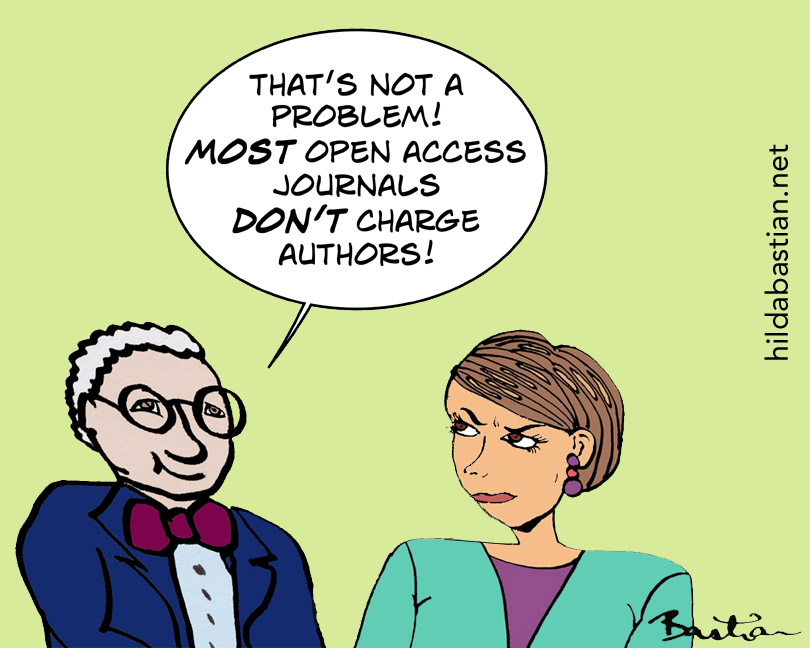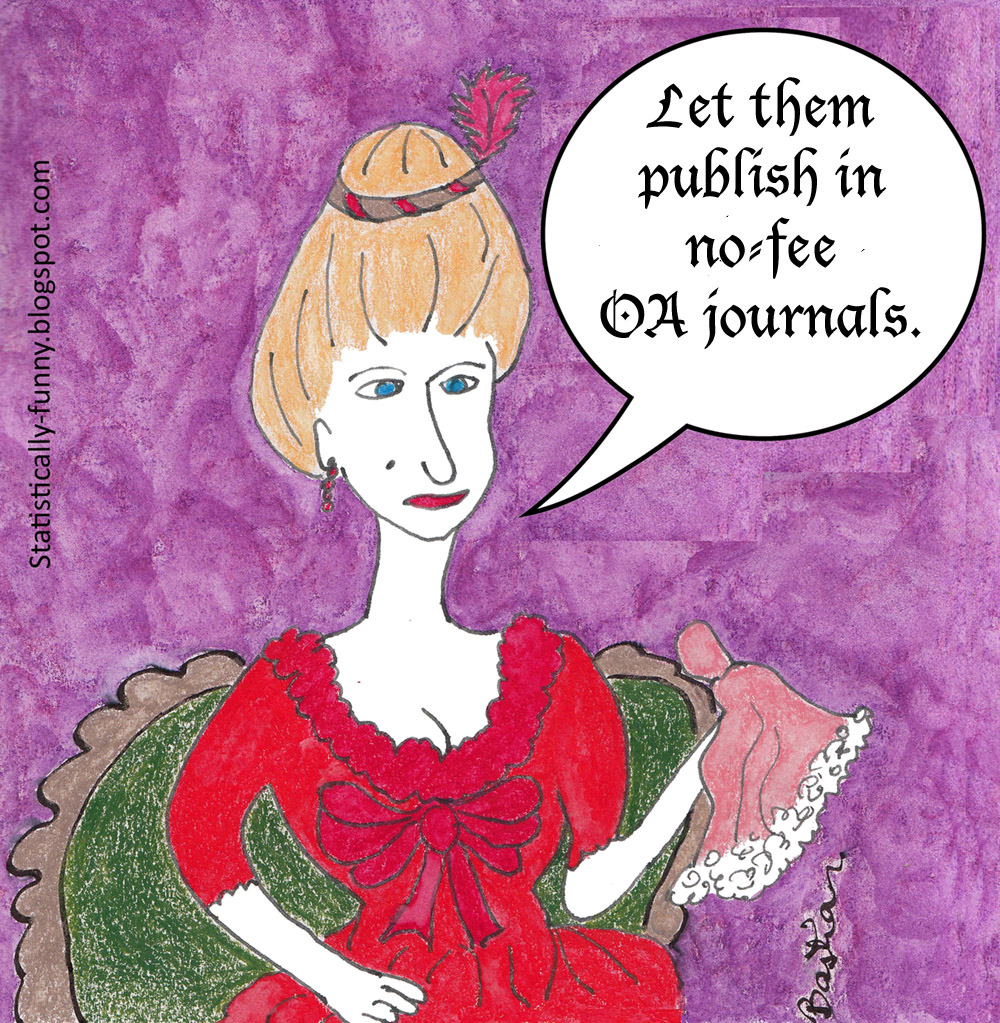A Reality Check on Author Access to Open Access Publishing

Technically, the “most journals don’t charge authors” statement could well be true. Most open access journals may not charge authors. The source that’s used to support the claim is generally DOAJ – the Directory of Open Access Journals. One of the pieces of meta-data for journals in DOAJ is whether or not the journal levies an APC – an author processing charge for an open access (OA) publication.
But I think this is a data framing that’s deeply misleading. And it does harm. As long as people can argue that there are just so many options for fee-free publishing, then there will be less of a sense of urgency about eliminating, or at least drastically reducing, APCs. As Kyle Siler and colleagues show in the field of global health research, the APC is adding a new stratification of researchers globally, between those who can afford open publishing in highly regarded journals, and those who can’t.
A few weeks ago on Twitter, Ricky Poynder objected to the “most journals” argument as “deceptive”. The data isn’t useful out of context, he tweeted. I agreed with him, but there was a bit of an argument on Twitter about it.
Here’s what kicked it off: Heather Morrison, at the end of January, saying
71% of the 11,001 journals listed in DOAJ do not charge APCs. [Author’s emphasis]
This tells you nothing about the viability of “no-fee” OA publishing from an individual’s point of view. For a start, not having an APC doesn’t mean the journal is accessible to everybody. It has to accept work from your field. You have to be eligible to publish in it – an APC is not the only possible access issue. You have to write in its language of publication. And you want it to be accessible to people in your field. In mine, that means you really want it to be indexed in PubMed. And having DOIs is critical for citations to be counted by key systems.
What follows is my quick-and-dirty analysis of data from DOAJ, trying to get some perspective on the non-APC OA journals. I progressively narrowed down the dataset, from a biomedicine point of view, looking to find a set that might be indexed in PubMed – and then looked for them in PubMed. And because English is the lingua franca of biomedicine globally, I tried to hone in on those (even though that’s not necessary for PubMed indexing).
The DOAJ meta-data aren’t as accurate as they need to be for this kind of analysis, I found along the way. So that’s another caveat around what follows. Still, rough-hewn as it is, this analysis outlines some basic contours.
![]()
![]()
![]()
![]()
![]()
![]()
You can see them here. I’m sure there are quite a few more non-APC journals in biomedicine, given the shortcuts I took here. And the DOAJ isn’t comprehensive, either: Mads Svane Liljekvist and colleagues found that of a set of fully OA biomedical journals they studied, 13% were missing from DOAJ.
Even if there are quite a few more, this important sector would clearly still be very small. There were over a million articles published in PubMed in 2017. A hefty chunk of them were OA. So just under 10,000 in all APC-free journals combined doesn’t provide a lot of capacity. PLOS One alone published over 21,000 articles in 2017: 30% of these journals published less than 50.
When you look at the data, a few things jump out at you. These journals are often regional – and often so locale-specific, that the journal is that of a department of a university. And while some of these journals accept contributions from others, free services to those associated with an institution seems to represent a significant part of this neck of the publishing woods.
Many are based in regions that aren’t high status in biomedical science. And while there are of course well-known and highly-respected journals in their fields among them, consigning authors to the non-fee journal sector is to send them to a tier of journal that the APC-supported community of authors would, by and large, not think was good enough for themselves. If the DOAJ meta-data on DOIs is accurate, the lack of them alone – and the citation tracking that goes with me – would be a knock-out criterion to most. That is, if they even knew of them: with nearly 90% not indexed PubMed, and low publication rates, the chances of stumbling upon one is pretty low.
No one is intending to send this message, I know. But to me, this flippant framing of data from people with the privilege of supported APCs, is starting to look uncomfortably close to this:

Having done some analysis of the data, I agree with Ricky Poynder’s choice of word. Framing the data about non-fee OA journals only from the point of view of number of journals is deceptive.
Meanwhile, what are your options if the APCs of the journals you need to publish in are out of your reach? You could find out which ones will accept your work after you’ve posted it as an open access preprint – and check, too, that you can post your final authors’ manuscript in an institutional repository that will be picked up by Google Scholar. (Fee waivers might also be an option, but that’s a topic for another day.)
I’ve focused on the weaknesses of non-APC journals. I don’t want that to be the final take-away message though. This sector could grow, especially if more academic institutions provided more publishing support to their personnel – or embraced consortium models like the Open Library of Humanities model. Scholarly publishing without subscriptions or author fees, on scale, means considerable investment. I hope it happens. In the meantime, please don’t give the impression that it’s an accessible option for most authors. Unfortunately, it probably isn’t yet.
~~~~
The cartoons are my own (CC BY-NC-ND license). (More cartoons at Statistically Funny and on Tumblr.)
The data in this post come from a March 2018 version of the DOAJ meta-data CSV download. [Update on 5 April – delay due to traveling] Key steps for my analyses are in this Google spreadsheet.
* The thoughts Hilda Bastian expresses here at Absolutely Maybe are personal.

I love PLOS, but it’s quite precious to read in the PLOS blog about the need for a “sense of urgency about eliminating, or at least drastically reducing, APCs” when some PLOS journals charge 2900 $ APCs. Granted, PLOS offers much better value than legacy publishers, especially those who charge 5000 $ APCs, and I understand the marketing necessity of not being seen as “cheap”, but still.
I agree that it can be misleading to talk about “most” journals: what really matters is whether the individual researcher has the real opportunity to publish *their* publication APC-free in a good OA journal, within realistic times. It would be nice to have a breakdown
But then, let’s talk about medicine. A quick search on DOAJ finds a few journals in the medicine field which have the DOAJ seal, are APC-free and have published several hundreds of articles. Two are published by academic societies in Argentina and Italy.
“Salud Colectiva” (despite the unfree CC-BY-NC license) seems a very valuable endeavour, as every article submitted in English or Portuguese is translated to Spanish: http://revistas.unla.edu.ar/saludcolectiva/Idiomas
https://doaj.org/toc/1851-8265
https://doaj.org/toc/2240-2683
It seems a valuable option that a researcher should consider (especially if Spanish-speaking; translation is a cost), not something to dismiss as a threat to the supposed model of “non-zero but lower than others” APC-based journals. And this is just something I have found with a 5 minutes search.